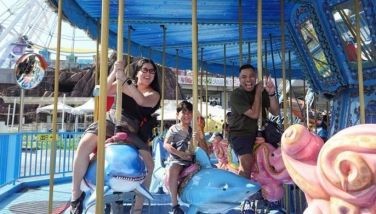‘Ukay-ukay’ chic
July 16, 2001 | 12:00am
In hard times like these, just about the only way you can get anything new is to buy, well, something used–or, at least, something sold for a bargain.
We Pinoys are world-class experts at sniffing out these bargains. Unleash three Pinoys on a market or a mall and you can bank on meeting them a couple of hours later with the best buys in the place–though not necessarily things you need or would have ever thought of, like that bamboo backscratcher ("I got six of them–you know, for Christmas") and that set of six tumblers in the rainbow-swirl pattern ("It would’ve been criminal to let them go, knowing what they normally cost").
That’s fine for impulse buying–at which, again, we must be global leaders (where else can anyone even think of selling a fuzzy tiger with a bobbing head at the traffic light?). But what do you do and where do you go for the things you absolutely need, such as that apple-green shirt (to go with the pink, the periwinkle, the tangerine, and the purple ones you already have), and that slightly used, 17-inch monitor that your CPU can’t live without?
Why, you go to a place like Surplus Shop, of course, or to HMR (on Sheridan St. in Pasig City)–just two of a slew of places around the city that sell either brand-new goods at heavily discounted prices (you can get an export-surplus Abercrombie & Fitch shirt at Surplus Shop for less than P250) or second-hand stuff dirt-cheap (whole computer systems for less than P5,000 at HMR). Even better and cheaper than that, you can scour the tiangge markets and the ukay-ukay shops around the country for the best of last year’s fashions (well, maybe the last decade’s)–all yours for the price of a pair of socks at the mall.
I realized that a sea change was happening in the economy when one of the tonier houses in the neighborhood put up a big sign advertising itself as an ukay-ukay center.
The ukay-ukay concept may be nothing new to places like Baguio City, where containers full of used clothes arrive everyday from Hong Kong (how and why they end up on a mountaintop beats me), to be snapped up by visiting lowlanders. You can still find the now-venerable Eloy’s on Kamuning in Quezon City, flanked by half a score of pretenders and other used-goods minimarts selling everything from chintzy sofas to bread toasters with the blackened traces of a thousand breakfasts entrenched firmly in their cavities.
If there are such things as second-hand treasures, then there are also, you might say, second-foot retreads, recycled shoes as deeply creased as your grandfather’s face but lovingly "Joe-Bushed" (bet you haven’t heard that word in a while) and shined up to earn their places on Manila’s sidewalk bazaars. And definitely second-hand (second-ear?), albeit involuntarily, are the "used" cellphones sold at Arranque Market, from which you can almost imagine the snatching victim’s blood having been wiped off in greasy splotches (don’t you just love the way we writers think?).
Still, for all these, we Pinoys have a long way to go towards institutionalizing resale shops the way you find them in every nook and cranny of the United States and the United Kingdom, where your choices can range from the basement-grade Salvation Army store to the more upscale high-fashion shops specializing in "vintage" clothing of the kind that Holywood stars draped themselves in the 1940s. That requires a degree of cultural acceptance of the old, the used, and the cheap–to which, despite whatever we may admit privately, a great amount of public resistance still exists. In other words, it’s still anathema for many a Pinoy to be caught wearing something literally taken off the back of a perfect stranger who may, for all intents and purposes, be mouldering six feet underground. We imagine exotic skin diseases and horrible karmas transmittable to the next wearer.
I wonder if it’s our penchant–imbibed, I suspect, from the Chinese–for new and shiny things to blame. This is the mindset that refuses to peel away the thin plastic wrapper on the sidings of new cars even when they’ve begun to blister like you would three days after the beach. No Pinoy’s Christmas or New Year would be complete without new clothes and new shoes, and nothing can be more unfashionable than last year’s cellphone model, now good only for the maids (the kids, in all likelihood, will have newer and fancier cellphones than yours). Where the essentials of life are largely immutable, you’d have only the trappings to play with, and we change surfaces like itchy chameleons, buying and contenting ourselves with the subcutaneous thrills of novelty. The shimmering promises of the future, rather than the graven provenance of the past, are what hold our attention.
That’s a mouthful to say about ukay-ukay, but it’s only to propose that while we may have put too high a premium on new and expensive things, our attitudes are slowly but surely changing. Youth and the falling peso have done what they could to promote the acceptability–if not the reverse chic-ness–of the ukay-ukay lifestyle (which, let’s remind ourselves, is the way 90 percent of our people live, through none of their own free will).
I’m not ashamed to say that I have been a connoisseur of second-hand bargains all my adult life. With the exception of my barongs, nearly all my clothes come from Surplus Shop. Many of my happiest memories of America and Britain took place in resale outlets and weekend rummage sales, where I got thick woollen sweaters–the kind you’d need for a winter or two, then leave behind–for a couple of dollars apiece. While some people might draw the line at used shoes, I don’t. Once, faced with a pair of good shoes selling for $5 in Wisconsin, I took one look at my feet, which will never make the centerfold of Podiatrist’s Monthly, and convinced myself that they were better off being sheathed in those pennyloafers; they lasted me 10 years. And you can’t get more second-hand–literally, now–than old fountain pens, my specimens of which often lead me to wonder whose hands had held them, and to what purpose: what letters and lines of love and delight and sorrow they must have written, how they must have flown and skipped and trembled in the fingers of their now long-departed masters.
You may not get that kind of lift from a hand-me-down T-shirt or pair of jeans–but as far as I’m concerned, getting anything for a tenth or even a quarter of the cost of new is thrilling enough, if only because you would’ve saved yourself some cash for that new backpack or those new shades you saw at the mall and just have to have, the full price be damned.
And speaking of bargains, how about checking out the world’s largest ukay-ukay, eBay (www.ebay.com)? A friend of mine wrote me last week to ask "What do I need to know about Ebay?"
Ebay is the world’s largest private on-line trading community, with almost 30 million registered users since September 1995; last year it did $5 billion worth of business on mostly used goods. You can buy and sell practically anything on eBay, and a growing number of Filipinos have gotten into the act. I myself have been trading on eBay for four years now as "penmanila," buying and selling computer items, old pens, car parts, books, and postcards. Ebay is a fabulous cornucopia of goods–type an object into the "search" box and it’ll almost certainly turn up among the 1.2 billion items eBay has sold (eBay itself doesn’t really sell anything, but merely facilitates transactions).
What you need to remember is that this is an on-line and therefore anonymous market–so, as they say, caveat emptor: let the buyer beware. There are cheats and con men out there, but they are the exceptions by and large; in over a hundred transactions, I’ve been shortchanged only once or twice, and got my money back. So it’s safe for the most part, but be careful. Use eBay’s "feedback" system to check out the seller’s credentials (they should have little or no negative feedback).
Don’t bid more than you can afford to pay, and don’t bid too much too early. Establish the going price for the goods under "completed items." Here’s an invaluable tip: be on-line the last five minutes of bidding (that’s eBay time, PST in the US). That’s when the truly serious bidding takes place. Put in your highest possible bid at the very last minute or the dying seconds (that’s called "sniping," which is perfectly legitimate).
When bidding, factor in the shipping costs and arrangements. Most eBay sellers are US-based and don’t ship internationally, so it’s best to have a US-based credit card or a relative in the US who will pay for and receive items for you. You might be liable for customs duties, on top of what shippers like Fedex or UPS will charge. For non-critical items, I just use plain old US Postal Service, which has a cheap "global priority" rate for small parcels.
When paying, never send your credit card number by e-mail (use phone or fax or a secure website). Paypal is the best payment system, although it’s still largely US-based. Happy hunting!
Send e-mail to Butch Dalisay at penmanila@yahoo.com.
We Pinoys are world-class experts at sniffing out these bargains. Unleash three Pinoys on a market or a mall and you can bank on meeting them a couple of hours later with the best buys in the place–though not necessarily things you need or would have ever thought of, like that bamboo backscratcher ("I got six of them–you know, for Christmas") and that set of six tumblers in the rainbow-swirl pattern ("It would’ve been criminal to let them go, knowing what they normally cost").
That’s fine for impulse buying–at which, again, we must be global leaders (where else can anyone even think of selling a fuzzy tiger with a bobbing head at the traffic light?). But what do you do and where do you go for the things you absolutely need, such as that apple-green shirt (to go with the pink, the periwinkle, the tangerine, and the purple ones you already have), and that slightly used, 17-inch monitor that your CPU can’t live without?
Why, you go to a place like Surplus Shop, of course, or to HMR (on Sheridan St. in Pasig City)–just two of a slew of places around the city that sell either brand-new goods at heavily discounted prices (you can get an export-surplus Abercrombie & Fitch shirt at Surplus Shop for less than P250) or second-hand stuff dirt-cheap (whole computer systems for less than P5,000 at HMR). Even better and cheaper than that, you can scour the tiangge markets and the ukay-ukay shops around the country for the best of last year’s fashions (well, maybe the last decade’s)–all yours for the price of a pair of socks at the mall.
I realized that a sea change was happening in the economy when one of the tonier houses in the neighborhood put up a big sign advertising itself as an ukay-ukay center.
The ukay-ukay concept may be nothing new to places like Baguio City, where containers full of used clothes arrive everyday from Hong Kong (how and why they end up on a mountaintop beats me), to be snapped up by visiting lowlanders. You can still find the now-venerable Eloy’s on Kamuning in Quezon City, flanked by half a score of pretenders and other used-goods minimarts selling everything from chintzy sofas to bread toasters with the blackened traces of a thousand breakfasts entrenched firmly in their cavities.
If there are such things as second-hand treasures, then there are also, you might say, second-foot retreads, recycled shoes as deeply creased as your grandfather’s face but lovingly "Joe-Bushed" (bet you haven’t heard that word in a while) and shined up to earn their places on Manila’s sidewalk bazaars. And definitely second-hand (second-ear?), albeit involuntarily, are the "used" cellphones sold at Arranque Market, from which you can almost imagine the snatching victim’s blood having been wiped off in greasy splotches (don’t you just love the way we writers think?).
Still, for all these, we Pinoys have a long way to go towards institutionalizing resale shops the way you find them in every nook and cranny of the United States and the United Kingdom, where your choices can range from the basement-grade Salvation Army store to the more upscale high-fashion shops specializing in "vintage" clothing of the kind that Holywood stars draped themselves in the 1940s. That requires a degree of cultural acceptance of the old, the used, and the cheap–to which, despite whatever we may admit privately, a great amount of public resistance still exists. In other words, it’s still anathema for many a Pinoy to be caught wearing something literally taken off the back of a perfect stranger who may, for all intents and purposes, be mouldering six feet underground. We imagine exotic skin diseases and horrible karmas transmittable to the next wearer.
I wonder if it’s our penchant–imbibed, I suspect, from the Chinese–for new and shiny things to blame. This is the mindset that refuses to peel away the thin plastic wrapper on the sidings of new cars even when they’ve begun to blister like you would three days after the beach. No Pinoy’s Christmas or New Year would be complete without new clothes and new shoes, and nothing can be more unfashionable than last year’s cellphone model, now good only for the maids (the kids, in all likelihood, will have newer and fancier cellphones than yours). Where the essentials of life are largely immutable, you’d have only the trappings to play with, and we change surfaces like itchy chameleons, buying and contenting ourselves with the subcutaneous thrills of novelty. The shimmering promises of the future, rather than the graven provenance of the past, are what hold our attention.
That’s a mouthful to say about ukay-ukay, but it’s only to propose that while we may have put too high a premium on new and expensive things, our attitudes are slowly but surely changing. Youth and the falling peso have done what they could to promote the acceptability–if not the reverse chic-ness–of the ukay-ukay lifestyle (which, let’s remind ourselves, is the way 90 percent of our people live, through none of their own free will).
I’m not ashamed to say that I have been a connoisseur of second-hand bargains all my adult life. With the exception of my barongs, nearly all my clothes come from Surplus Shop. Many of my happiest memories of America and Britain took place in resale outlets and weekend rummage sales, where I got thick woollen sweaters–the kind you’d need for a winter or two, then leave behind–for a couple of dollars apiece. While some people might draw the line at used shoes, I don’t. Once, faced with a pair of good shoes selling for $5 in Wisconsin, I took one look at my feet, which will never make the centerfold of Podiatrist’s Monthly, and convinced myself that they were better off being sheathed in those pennyloafers; they lasted me 10 years. And you can’t get more second-hand–literally, now–than old fountain pens, my specimens of which often lead me to wonder whose hands had held them, and to what purpose: what letters and lines of love and delight and sorrow they must have written, how they must have flown and skipped and trembled in the fingers of their now long-departed masters.
You may not get that kind of lift from a hand-me-down T-shirt or pair of jeans–but as far as I’m concerned, getting anything for a tenth or even a quarter of the cost of new is thrilling enough, if only because you would’ve saved yourself some cash for that new backpack or those new shades you saw at the mall and just have to have, the full price be damned.
Ebay is the world’s largest private on-line trading community, with almost 30 million registered users since September 1995; last year it did $5 billion worth of business on mostly used goods. You can buy and sell practically anything on eBay, and a growing number of Filipinos have gotten into the act. I myself have been trading on eBay for four years now as "penmanila," buying and selling computer items, old pens, car parts, books, and postcards. Ebay is a fabulous cornucopia of goods–type an object into the "search" box and it’ll almost certainly turn up among the 1.2 billion items eBay has sold (eBay itself doesn’t really sell anything, but merely facilitates transactions).
What you need to remember is that this is an on-line and therefore anonymous market–so, as they say, caveat emptor: let the buyer beware. There are cheats and con men out there, but they are the exceptions by and large; in over a hundred transactions, I’ve been shortchanged only once or twice, and got my money back. So it’s safe for the most part, but be careful. Use eBay’s "feedback" system to check out the seller’s credentials (they should have little or no negative feedback).
Don’t bid more than you can afford to pay, and don’t bid too much too early. Establish the going price for the goods under "completed items." Here’s an invaluable tip: be on-line the last five minutes of bidding (that’s eBay time, PST in the US). That’s when the truly serious bidding takes place. Put in your highest possible bid at the very last minute or the dying seconds (that’s called "sniping," which is perfectly legitimate).
When bidding, factor in the shipping costs and arrangements. Most eBay sellers are US-based and don’t ship internationally, so it’s best to have a US-based credit card or a relative in the US who will pay for and receive items for you. You might be liable for customs duties, on top of what shippers like Fedex or UPS will charge. For non-critical items, I just use plain old US Postal Service, which has a cheap "global priority" rate for small parcels.
When paying, never send your credit card number by e-mail (use phone or fax or a secure website). Paypal is the best payment system, although it’s still largely US-based. Happy hunting!
BrandSpace Articles
<
>




















